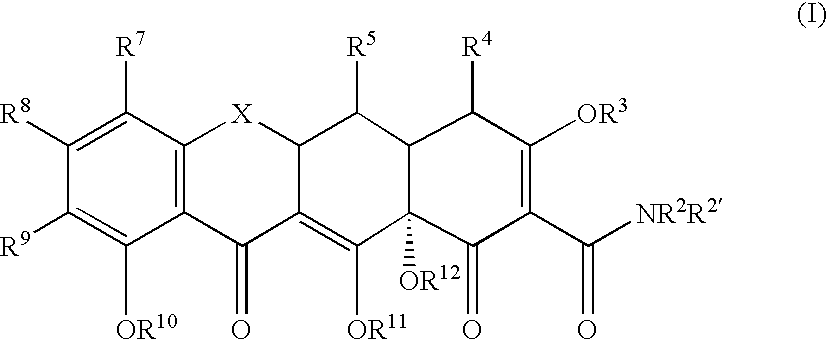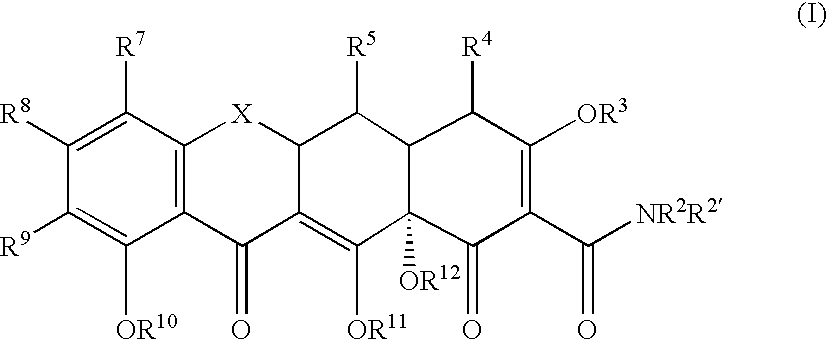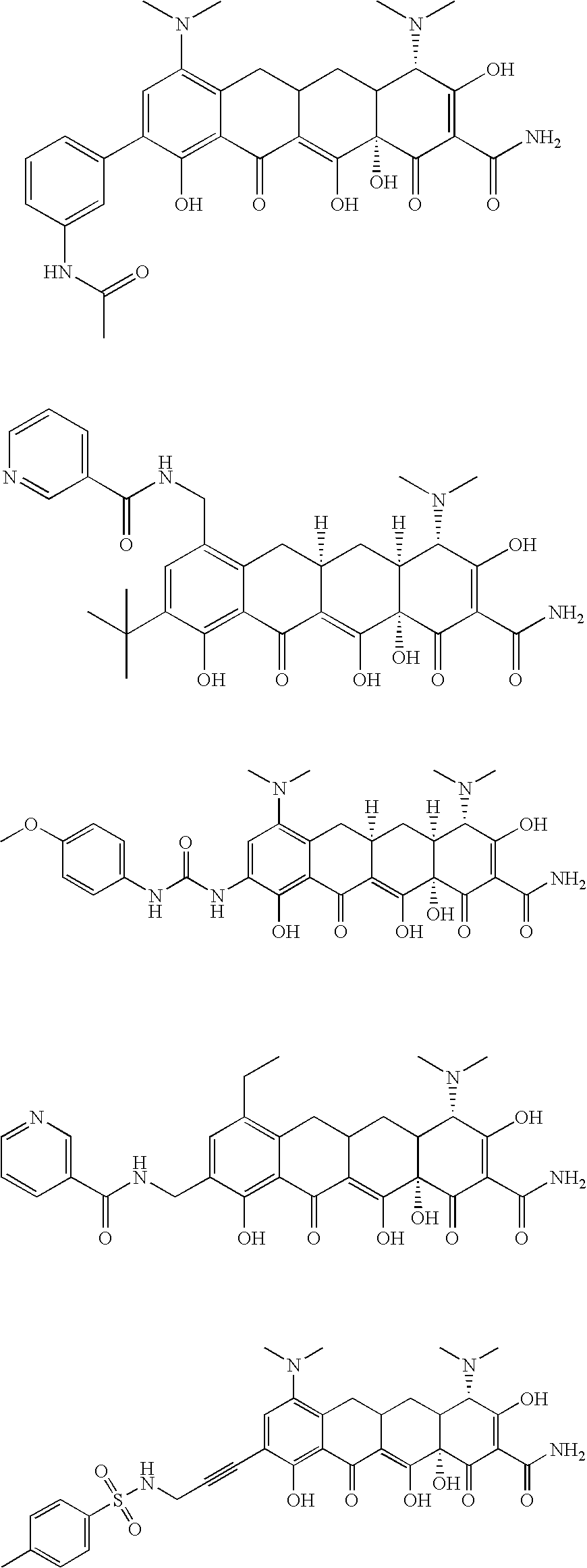Substituted tetracycline compounds as synergistic antifungal agents
a technology of tetracycline and antifungal agent, which is applied in the direction of biocide, drug composition, immunological disorders, etc., can solve the problems of lagging antifungal activity of drugs, little medical impetus for pharmaceutical companies to develop novel treatments, and increasing the incidence of systemic fungal infections that cause these fatalities, so as to increase the antifungal activity of an antifungal agent and increase the antifungal activity of the antifungal agent.
- Summary
- Abstract
- Description
- Claims
- Application Information
AI Technical Summary
Benefits of technology
Problems solved by technology
Method used
Image
Examples
example 1
Synthesis of Tetracycline Compounds
[0136] The following example discusses methods of synthesizing the tetracycline compounds of the invention. Other compounds of the invention can be synthesized using techniques discussed in the application and / or by using art recognized methods.
[0137] Experimental
[0138] Melting points were taken on a Mel-Temp capillary melting point apparatus and are uncorrected. Nuclear magnetic resonance (1H NMR) spectra were recorded at 300 MHz on a Bruker Avance spectrometer. The chemical shift values are expressed in δ values (ppm) relative to tetramethylsilane or 3-(trimethylsilyl)-1-propanesulfonic acid, sodium salt, as either an internal or external standard using CDCl3, DMSO-d6, or MeOH-d4 as the solvent. Column chromatography was performed according to the method of Still using Baker “flash” grade silica gel (40 μm) that was treated with a saturated solution of Na2EDTA, washed with water, filtered and dried in an oven at 130° C. for three hours prior t...
example 2
Synergetic Antifungal Activity of Substituted Tetracycline Compounds with Amphotericin B
[0172] Synergetic antifungal activity of the substituted tetracycline compounds was determined by a broth microdillution technique following NCCLS (1997) Standards. Assays were setup using a Tecan Genesis robotic workstation. All drugs were dissolved in DMSO and diluted appropriately. Drug concentration ranged from 0.125 to 64 μg / mL in 2 fold serial dilutions. Each tetracycline was tested at 10 concentrations ranging from 0.125 to 641 g / mL. The compounds were tested for their antifungal activity against Candida albicans (ATCC#90028). Amphotericin B was added to all wells of the plate at a concentration of 10 fold less than the amphotericin B MIC (0.5 μg / mL). The strains tested include those listed in Table 1.
TABLE 1GenusSpeciesATCC / FGSC #AspergillusfumigatusATCC 13073 (Fresenius)AspergillusnidulansFGSCA991 (wt)CandidaalbicansATCC 90028CandidaalbicansPCI-1 CandidaalbicansPCI-17CandidaalbicansAT...
example 3
In Vitro Cytotoxicity Assay of Tetracycline Compounds: Mammalian Cytotoxicity Assay
[0177] COS-1 and CHO Cell suspensions were prepared, seeded into 96-well tissue culture treated black-walled microtiter plates (density determined by cell line), and incubated overnight at 37° C., in 5% CO2 and approximately 95% humidity. The following day serial dilutions of drug were prepared under sterile conditions and transferred to cell plates. Cell / Drug plates were incubated under the above conditions for 24 hours. Following the incubation period, media / drug was aspirated and 50 ml of Resazurin was added. Plates were then incubated under the above conditions for 2 hours and then in the dark at room temperature for an additional 30 minutes. Fluorescence measurements were taken (excitation 535 nm, emission 590 nm). The IC50 (concentration of drug causing 50% growth inhibition) was then calculated for each compound.
[0178] In Table 2, toxicities greater than >25 μg / ml are represented by * and tox...
PUM
| Property | Measurement | Unit |
|---|---|---|
| Composition | aaaaa | aaaaa |
Abstract
Description
Claims
Application Information
 Login to View More
Login to View More - R&D
- Intellectual Property
- Life Sciences
- Materials
- Tech Scout
- Unparalleled Data Quality
- Higher Quality Content
- 60% Fewer Hallucinations
Browse by: Latest US Patents, China's latest patents, Technical Efficacy Thesaurus, Application Domain, Technology Topic, Popular Technical Reports.
© 2025 PatSnap. All rights reserved.Legal|Privacy policy|Modern Slavery Act Transparency Statement|Sitemap|About US| Contact US: help@patsnap.com



